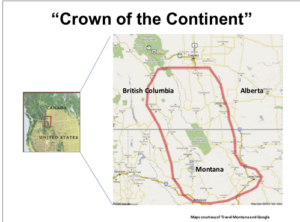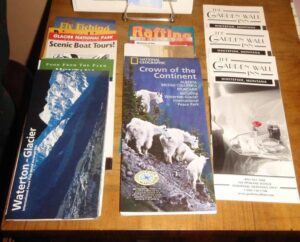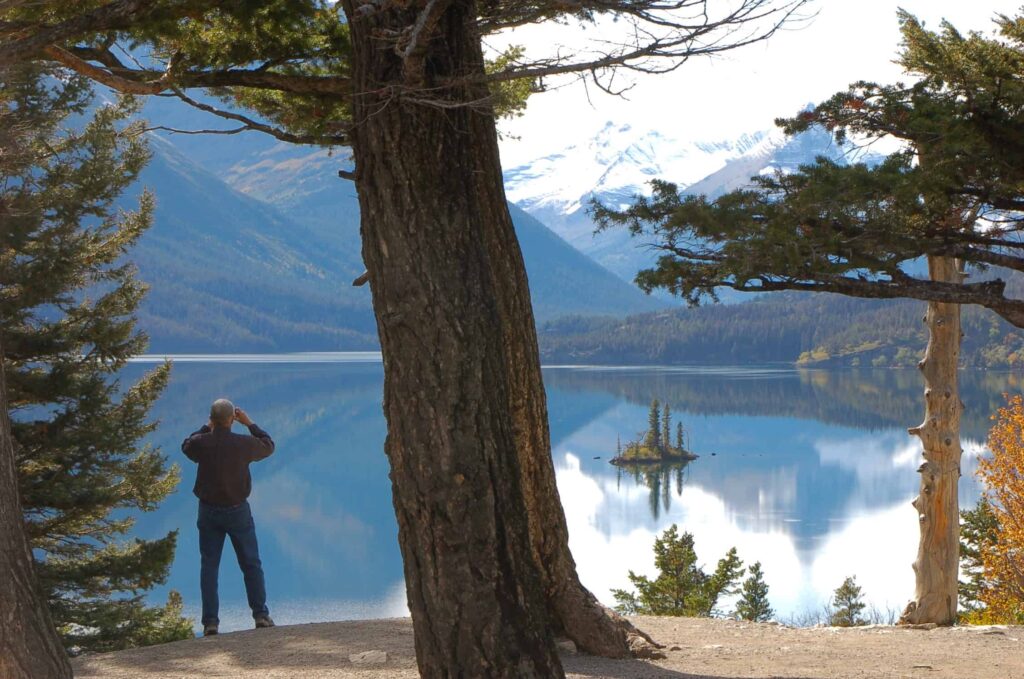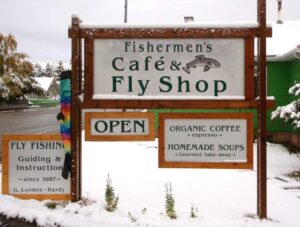[Above: Rocky Mountain skyline at Glacier National Park, Montana. All photos by Jonathan Tourtellot.]
Editor’s note: As destinations plan for eventual recovery from the pandemic, they have an unprecedented opportunity to manage tourism more effectively. With this post about North America’s “Crown of the Continent,” we offer the third in our profiles of destination organizations that approach the standard set forth in the Global Sustainable Tourism Council’s critical destination-management Criterion A1, which reads in part:
“The destination has an effective organization, department, group, or committee responsible for a coordinated approach to sustainable tourism, . . . for the management of environmental, economic, social, and cultural issues.”
This holistic requirement seems obvious, yet very few places around the world come close to meeting it. Below is Ellen Rugh’s profile of another one that does: the “Crown of the Continent.” We hope this information will provide other places with ideas on how better to manage tourism’s hazards and benefits. To join in our search for more examples of holistic destination management, or submit a candidate for profiling, read more here.
Crown of the Continent Geotourism Council –
Montana, Alberta, and British Columbia
N.B. – This report was compiled before the onset of the 2020 coronavirus pandemic. It is based on Destination Stewardship Center questionnaire responses and follow-up interviews.
Introduction
Since 2006, the Crown of the Continent Geotourism Council has become a strong and active transboundary partnership, characterized by a high level of commitment, cooperation, and collaboration between local stakeholders in Alberta, British Columbia, and Montana. Although not a legally mandated organization, the Council has found their success, their respondents told us, by carefully selecting a group of individuals “who are all willing to work beyond borders, and while they can have varying opinions about how to resolve certain issues, they all strive for the same end goals.” Covering a 7.3-million-hectare region (18 million acres), the Crown of the Continent Geotourism Council prides itself on the vast number of stakeholders within their network, including crucial tribal relationships. The Council focuses on creating local experiences for visitors, allowing any local residents, from tourism practitioners to the mom down the street, to propose sites and attractions for the Council to include in its MapGuide, so long as they meet the principles of geotourism as originally put forth via National Geographic: “Tourism that sustains or enhances the geographical character of a place – its environment, culture, geology, aesthetics, heritage, and the well-being of its residents.”
Geographic Description
The Crown of the Continent encompasses  approximately 73,000 sq kilometers (about 28,000 sq miles). Its transboundary jurisdiction includes the Waterton-Glacier International Peace Park and the surrounding lands and communities in Alberta, British Columbia, and Montana, including five First People nations. The region includes within its jurisdiction over 680 sites, attractions, and accommodations.
approximately 73,000 sq kilometers (about 28,000 sq miles). Its transboundary jurisdiction includes the Waterton-Glacier International Peace Park and the surrounding lands and communities in Alberta, British Columbia, and Montana, including five First People nations. The region includes within its jurisdiction over 680 sites, attractions, and accommodations.
Context
The Crown of the Continent Geotourism Council’s transboundary partnership was created through their first catalyst project, a National Geographic Geotourism MapGuide, in an effort to implement cooperative projects that expand or enhance visitor and resident opportunities and encourage sustainable businesses through geotourism activities, including stewardship, education, and regional promotion. Such a task becomes crucial in an area dotted by small towns, whose voice in protecting the natural and cultural heritage of the area may not typically be heard, and the National Geographic requirement for citizen participation provided an opportunity for them.
To maintain their success as a transboundary organization, the Crown of the Continent Geotourism Council thrives on effective partnerships and attributes success to “the relationships, a shared pride in the region, and the potential to develop the economies of the communities while stewarding, enhancing, and celebrating our special character of place.” The Council’s network is enormous, with 33,099 e-newsletter subscribers as of 2016. With their flexibility and reputation for collaboration, the Crown says that “stakeholders often approach us for assistance, because we know so many people in the region and have a vast database. Especially in an 18 million acre region, connecting with the locals and connecting the locals with each other, is one of our most valuable assets.”

To leverage such a vast network, 195 volunteer field experts within the Council provide recommendations for what the Council features on their platforms and MapGuides. These authentic “hyperlocal” tourist offerings comprise the community-based businesses, organizations, and points of interest that would be typically overlooked by an outsider. Field experts may be an officially nominated tourism practitioner or just a resident citizen with a passion for sharing her locale with others. The Council acknowledges that these locals hold the most knowledge and connection to the place. Their recommendations on the best places to visit, places to stay, and things to do are then vetted by the project coordinator under National Geographic oversight. Crown of the Continent takes pride that each nomination shared with visitors is a place most respected and regarded by locals.
Activities
The Council labels themselves a content development and curation program. All content within their website, MapGuides, and social media pages must meet geotourism principles as originally set forth by National Geographic.

The Council promotes buying local; employing locals; green purchasing; staying in eco-friendly and locally-owned unique lodging; participating in human-powered activities; volunteering; visiting First Nation and Tribal Lands, designated dirt roads, and scenic routes; and stepping away from your car. Starting in 2016, the Council has sent their listed organizations and businesses a window decal and digital link badge that identify them as a National Geographic Crown of the Continent Destination, all at no charge.
While the Council does not have the capacity to plan events and activities on their own, they do promote unique and authentic festivals and events on their website and MapGuide, including powwows, Earth Day Celebrations, sustainable-forestry tours and programming, bioblitzes, wildlife and wildflower festivals, heritage and culture celebrations, rodeos, volunteer opportunities, and “Green” contests. Both local residents and visitors may participate in these activities.
Given their broad network and insight on all of the unique offerings throughout the region, the Council develops trip plans that focus on hyperlocal experiences and moving the visitor (and residents) around the region. As the Council explaines, visitors typically come to the region with a preplanned “Plan A” (typically, Glacier National Park or Waterton Lakes National Park), and once they arrive, usually decide on their “Plan B” (places to go, places to stay, and things to do outside of the National Parks).

With so many different experiences available, the Council coaches local businesses on how to steer visitors towards unique, authentic, and hyperlocal experiences by advising on digital marketing strategies, customer service techniques, and suggested messaging when recommending experiences. The Council says that most businesses have a desktop copy of the physical National Geographic Crown of the Continent Mapguide to use as a quick reference, and their website has a “Trip Plan” feature that allows businesses to create custom Trip Plans for their respective customers. These Trip Plans can be shared via their social media platforms, sent as an email, or embedded as a widget on their website.
Give its vast land coverage, the Council has found it difficult to take a direct lead on product development. Their strength is in giving others the tools to develop distinctive experiences through capacity building, networking, and promotion. However, they will jump in when a special project arises, such as in 2016, when they assisted in the creation of “Crown of the Continent: The Wildest Rockies,” a large-format photo exhibition and book. The exhibition was displayed in the C.M Russell Museum, the Montana State Capital, the US Senate Building’s Russell Rotunda, and the Waterton-Glacier International Peace Park. Hard copies of the book are still sold in Glacier National Park Conservancy’s online bookstore.
Organizational Structure and Governance
Given the bureaucratic complications that arise from being transboundary organization, the Council is not filed as a 501(c)3 or (c)4. Instead, it operates under a fiscal agent, the Whitefish Convention & Visitors Bureau, in Montana.
The Council is composed of 8-10 Executive Committee members and one project coordinator, representing over 730 businesses and organizations. The Executive Committee, who holds final decision-making authority, comprises representatives from the three major funding organizations, plus a combination of representatives from different agencies focusing on tourism, culture, or heritage. The Council tries to maintain at least one tribal representative on their Executive Committee at all times. Each member at-large provides beneficial input and fulfills a wide range of duties for the Council. The Executive Committee, along with anyone else affiliated with the Council, strives to adhere to geotourism principles.
There are no term limits for Executive Committee members, and because the organization does not require any formal mandates, there is no official election process. Instead, the organization has found their success by carefully selecting a group of individuals “who are all willing to work beyond borders, and while they can have varying opinions about how to resolve certain issues, they all strive for the same end goals.” Executive Committee members are involved depending on their available time commitment and employment status with their respective organizations. If an Executive Committee member wishes or needs to be phased out of the Executive Committee, the Committee selects a replacement at the Annual Executive Committee Retreat. When family health forced a key popular leader to step down during the Council’s formative years, the organization was thus able to carry on with relative ease. The Council’s goal is to always have someone representing the three core funders and the fiscal agent, plus like-minded conservation organizations, government entities, business owners, tribes, and DMOs.
This Executive Committee sets the long-term and annual strategic work plan. Special projects may require forming sub-committees. Most often, these groups include one or two Executive Committee members and several other individuals such as representatives from nonprofits, government agencies, businesses, DMOs, or people with a skill set that will elevate that project.
Informally, the Crown of the Continent Geotourism Council also organizes an arrangement of partners and members, with “partners” being those who disperse any information and announcements throughout the Crown’s network, and “members” being those who have passed the vetting process and are represented within the Council’s website and MapGuide. Last, the Council has an arrangement with volunteer field experts, who provide the hyperlocal recommendations that would be typically overlooked by an outside visitor.
Sustainability and Stewardship
The Council focuses all of their work in supporting the principles of geotourism and good destination stewardship, thus creating a model in which sustainability ties into every project. The “Events and Things to Do” listings on their website include information about “Leave No Trace” practices, wildlife encounter tips, volunteer opportunities, appropriate conduct when visiting cultural and heritage sites, who and how businesses support local conservation, and preservation and community beautification efforts.
• Indigenous peoples. The Council also takes care to include indigenous/tribal partners in all quadrants of the Crown of the Continent, actively seeking feedback from the First Peoples’ representatives who serve on the Executive Committee as partners. Indigenous/tribal content has been vetted and approved by respective First Nations before it is published. Each First Nation provides a strict list of places, experiences, and stories that are allowed to be shared. Even for content that may not seem directly related to First Peoples, the Council tries to share the cultural story behind a place. The goal is to be a platform for First Peoples to tell their stories in their voices.
• Restorative activities. In one case, the Council partnered in the planning, creation, and promotion of the Castle Parks in Alberta, an ecologically strategic piece of land of within Yellowstone-Yukon corridor previously viewed as a government-owned no-man’s land. Lack of enforcement, extractive industry, boondocking, and motorized vehicles had caused significant deterioration and degradation to sensitive ecosystems.

The Council helped push for proper planning, monitoring, and infrastructure for upgrading the area into park status, and promoting it via social media and the MapGuide.
• Climate mitigation. The Council has partnered with the Thompson Okanagan Tourism Authority to coordinate routes for installing electric charging vehicles across British Columbia. The British Columbia section is complete all the way to Crowsnest Pass, where Alberta is picking up the route. Most of the charging infrastructure has been installed in the Alberta section of Crown of the Continent and south to the U.S. border. Montana has begun the EV station installation process. Several other routes throughout the Crown are in development as an asset to both locals and tourists.
Managing Tourism Sustainably
While the Council does not have a formalized plan for addressing overtourism or mass tourism, they claim that given the nature of the region, most tourism products offered do not lend themselves to mass tourism, and it has not posed a threat thus far other than at overburdened Glacier National Park.

As the Council strictly adheres to the principles of geotourism, they focus all activities on authentic, local experiences that benefit local communities, dispersing visitors around the region and away from the national park. The Council helps promote recreational opportunities, especially trail systems beyond park boundaries. The policy is to follow strict criteria on what gets promoted, checking whether the area is ecologically or culturally sensitive, the trail is in good condition, and existing trailhead infrastructure (parking, outhouse, signage, etc) can support increased visitation.
The Council is helping to create a State of the Crown of the Continent Report to better understand and communicate a multitude of indicators for the region. This will direct future work, provide a measurement of the region’s health – of what’s going well and what isn’t – and provide a nonpolitical document that can be used to argue the importance of supporting, enhancing, and sustaining the region.
Additionally, the Council compiles a running list of areas and points of interest that they will not promote on their platforms, as the areas are either too fragile to handle increased visitation or are sacred sites. The Council works closely with government agencies, conservation organizations, and tribal representatives to ensure this list, for internal use only, is always up to date.
Community Engagement
The Crown of the Continent Geotourism Council encompasses stakeholders representing 53 organizations, tribal nations, agencies, and businesses,[1] who have contributed time, expertise, and/or financial support. The Council also has had an arranged partnership with National Geographic, which has cobranded their website and assists in the development and printing of the Crown of the Continent MapGuide. During the creation of this project, an even broader set of stakeholders were included to provided nominations, comments and ideas. The Council operates as an open‐invitation advisory committee of interested individuals, and has a networking relationship with local nonprofit organizations and universities, allowing all parties to leverage key resources. Says the Council Coordinator, Sheena Pate, “Our networking ability remains our greatest strength. Our government partners leverage to their advantage our nimble ability to move freely throughout the Crown of the Continent and our desire to always be connecting the region, since they are restricted on travel abilities and their already mandated work.”
Her tips for other destinations: “Bring together the willing. Be sure to have diversity of opinions.” The network is what gives their Council heft. “We find great joy in connecting those who work in their silos and have yet to realize their connection to other silos. We’re always putting the ‘puzzle pieces’ together and connecting what might be seen as differing voices.” The common ground? “Ultimately most of those living and working in the region are here because of the sense of place and outdoor heritage.”
The Crown of the Continent Geotourism Council does not serve as the locality’s official DMO. Each partner DMO contributes annually to the direction, planning, and funding of the transboundary partnership, while pursuing initiatives in their local jurisdictions that align with goals of the Geotourism Council. The Council claims that their success as a whole is an aggregation of all stakeholders, both DMOs and others, creating individual successes within their jurisdictions.
Furthermore, the Council not only works across the international border, but also across tribal nations. The Council reports that building these relationships has been pivotal, not only for responsible tourism development, but for external affairs as well: “Receiving the trust of local tribal groups is one of the most important things a destination stewardship council can do. While state and provincial governments within the Crown of the Continent jurisdiction have been working to accomplish this for years, they have moved in such a structured way. The Crown has been able to build trust much more quickly, through an informal, personal approach.” Tribal groups work with the Council directly on updating and adding points of interest on MapGuide and website.

The Council also serves on the planning committee for the annual Roundtable on the Crown of the Continent. The conference focuses on overarching issues, and the Council pulls in business and organization participation, recruits regional and national presenters and keynotes, solicits sponsors, and assists with marketing the conference. Tribal members, residents, students, government agencies, non-profit organizations, industries, and businesses all attend. The Council has lately shifted to an advisory role in order to give more attention to repeating the success of its 2018 Business of Outdoor Recreation Summit.
Funding
As of 2019, the Council’s budget falls at approximately $75,000 annually, predominantly funded by the Montana Department of Commerce’s Office of Tourism & Business Development, the Kootenay Rockies Tourism, and the Alberta Southwest Regional Alliance. This funding covers the project coordinator salary, website hosting and maintenance, branding, and any additional special projects, travel, and conferences. The Whitefish Convention & Visitors Bureau acts as the Council’s fiscal agent for free. Additional funding may be called upon for special projects, such as a MapGuide reprint.
Business and organizational membership is free including representation on the Crown of the Continent platforms (website, MapGuide, and social media). The Council says “no one pays to play” since these members already provide indirect financial support by paying membership fees to the Regional Tourism Alliances or Convention and Visitors Bureaus who, in turn, support the Council.
Measures of success
The Crown does not collect data as an organization. Instead, each region gathers its own visitor statistics, which the Council will evaluate to determine the quality of the visitors and tourism experience. Looking beyond visitation quantity, they seek to measure visitor demographics, such as income and age, as well as identifying each visitor’s length of stay, locations, and spending. They have found an increase in length of stay, with visitors more often frequenting local businesses. Lastly, they try to determine whether the most frequented businesses and accommodations are those that give back to the community or share messages of conservation.
Commentary
The Crown of the Continent Geotourism Council may prove that anything is possible if you put your mind to it and stay true to conscious, ethically minded stances. While sharing a similar set of geographic borders and tourism assets compared to B.C.’s Thompson Okanagan, this Council has taken a vastly different organizational approach. By bringing together the willing and a diverse set of stakeholders, the Council makes decisions that stretch far – opting for quality over quantity. With limited funding, Council members appear to be doing an excellent job of pushing their resources based on what is most important for that year, although I would love to see them expand their funding, add on another full-time staff, and get capacity to implement greater long-term strategy. With the funding that they do receive, the Council feels confident in their budget every year, even with a small selection of donors, due to their invaluable transboundary relationships across the US-Canadian border and across tribal nations, plus the thousands of stakeholders participating within their network. The National Geographic Geotourism MapGuide being critical to its genesis, the Crown of the Continent Geotourism Council demonstrates the value of a catalytic project that can blossom into much more robust initiatives.
On the other hand, the Council lacks an official mandate. While this allows for flexibility, it does create vulnerability. In fact, many other geotourism councils that started under the same National Geographic program have since fallen out of existence or lack true authority, which shows us both the fragility of unofficial organizations, but also the strength of the Crown in overcoming adversity and taking the correct course of action. Furthermore, while the National Geographic name provides major brand recognition, the arrangement is vulnerable. Funding may be needed to maintain this label, or National Geographic may drop the program. Last, given the changing landscape in technology and smartphone reliance, I wonder if evolving their successful MapGuide project from a mobile-friendly website into a true smartphone app will be critical in coming years.
We would like to collect more concrete examples of project implementation, both successes and failures. Our interviews were able to highlight a few examples, but limited timing still left us wanting more. —Ellen Rugh
[1] Organizations that have participated in the Crown of the Continent Geotourism Council include:
1) Alberta Ministry of Tourism, Parks and Recreation
2) Alberta Southwest Regional Alliance
3) Alpine Artisans Inc
4) Blackfeet Nation
5) Blood Tribe/Kainai Nation
6) Bureau of Land Management, United State Department of Interior
7) Castle Crown Wilderness Coalition
8) Chinook Country Tourist Association
9) Chinook Institute for Community Stewardship
10) College of the Rockies, Tourism Knowledge Cluster
11) Confederated Salish and Kootenai Tribes
12) Continental Divide Trail Alliance
13) Cowboy Trail Tourism Association
14) Dames on the Range
15) Fernie Chamber of Commerce/Tourism Fernie
16) Flathead Beacon
17) Flathead Convention and Visitor Bureau
18) Frank Slide Interpretive Centre
19) Glacier Country Regional Tourism Commission
20) Glacier National Park
21) Glacier Natural History Association
22) Southwest Montana Regional Tourism Commission
23) Henry P. Kendall Foundation
24) Kalispell Chamber / Convention & Visitor Bureau
25) Kootenay Rockies Tourism, British Columbia
26) Ktunaxa Nation
27) Miistakis Institute
28) Montana Department of Tourism and Business Development
29) Montana Scenic Loop
30) National Geographic Society, Center for Sustainable Destination
31) National Parks Conservation Association
32) National Park Service, United States Department of Interior
33) Pekisko Group
34) Rocky Mountain Grizzly Centre
35) Central Montana Regional Tourism Commission
36) Seeley Lake Chamber of Commerce
37) Sonoran Institute
38) Sustainable, Obtainable Solutions
39) Swan Valley Connections
40) The Sustainability Fund of Kalispell, Montana
41) Top 10 Scenic Drives in the Northern Rockies
42) Trail of the Great Bear
43) Travel Alberta
44) U.S. Forest Service, United State Department of Agriculture
45) University of Calgary, Program of Environmental Design
46) University of Montana, Center of Natural Resource and Environmental Policy
47) University of Montana, Institute for Tourism and Recreation Research
48) Waterton Lakes National Park
49) Waterton Park Chamber of Commerce
50) Whitefish Convention and Visitor Bureau
51) Wilburforce Foundation
52) Wildsight
53) Yellowstone-to-Yukon Conservation Initiative

